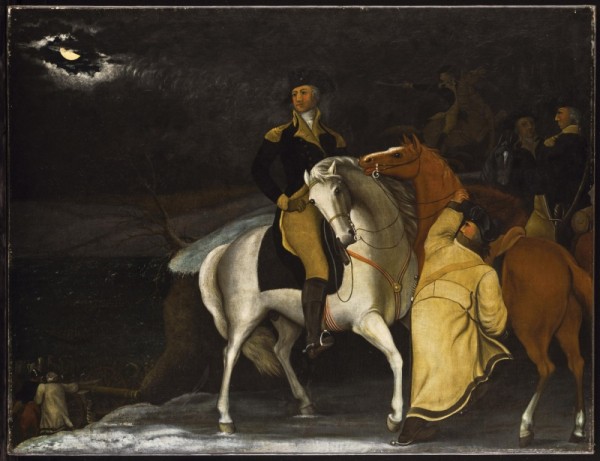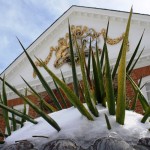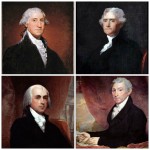 Between the snow and the sub-zero wind chills, this week feels like one of the worst cold snaps in recent memory (and with good reason). I checked with a meteorologist friend and she confirms we haven’t seen highs in the teens for 21 years. And we could break a record low temperature set all the way back in 1896! Still, this doesn’t seem much compared to some of the harsh winters our ancestors faced in the 18th century.
Between the snow and the sub-zero wind chills, this week feels like one of the worst cold snaps in recent memory (and with good reason). I checked with a meteorologist friend and she confirms we haven’t seen highs in the teens for 21 years. And we could break a record low temperature set all the way back in 1896! Still, this doesn’t seem much compared to some of the harsh winters our ancestors faced in the 18th century.
How do we know? It turns out our Founding Fathers were notorious weather watchers. In fact, there are quite a few journals and articles that detail Virginia’s harsh winters and crippling snowstorms. And while the National Weather Service didn’t start recording data until 1870, the government is able to share information from the 18th and 19th centuries thanks to the work of weather historian and author David Ludlum. Ludlum passed away in 1997 but not before publishing two books titled Early American Winters and the American Weather Book. He shared his research with NOAA and that’s where we found the bulk of the following information. Keep reading to find out exactly what made these storms go down in history.
18th-century Historic Winters
January 28, 1772: This storm was named the “Washington and Jefferson Snowstorm” since it was recorded in both of their diaries. The storm left nearly three feet of snow from Charlottesville to Winchester to Washington, D.C. In the middle of the blinding conditions, Jefferson and his new bride were struggling to return to Monticello following their wedding just weeks earlier on New Year’s Day. This storm remains the unofficial greatest snow in Virginia. Remember, the NWS didn’t start keeping official records until the 1800s.
May 4, 1774: Snow was reported in the Virginia Gazette to have fallen in Dumfries, Virginia. George Washington’s weather diary logged at Mount Vernon, that it was a cold day with “spits of snow and a hard wind from the northwest.” Thomas Jefferson was near Charlottesville and logged that the Blue Ridge Mountains were covered with snow. The late snow and frost killed most of the fruit crop in the northern part of the state.
December 25, 1776: Thomas Jefferson, at his home in Monticello, noted that on Christmas Eve, the temperature dropped significantly and by Christmas Day, almost two feet of snow had fallen. During that same storm, General Washington secured the Continental Army’s first major military victory of the war when he crossed an icy Delaware River at the Battle of Trenton. It snowed a total of ten times from December all the way into March.
The Hard Winter of 1779-1780: Imagine ice piled 20 feet high along the Virginia coast—ice that didn’t melt until the spring! NOAA reports the Virginia portion of the Chesapeake Bay froze and all rivers were solid enough to support the crossing of soldiers. As governor of Virginia, the Daily Press says “Thomas Jefferson reported that the Chesapeake Bay was solid from its head to the mouth of the Potomac.” He went on to say residents from Gloucester and Yorktown walked all the way across the frozen York River. The Virginia Gazette also published an account that “six loaded wagons went over the James River, on the ice, from Warwick to the opposite shore.”
January 1784: The Chesapeake Bay once again froze almost all the way to the mouth. Snow occurred between January 10-19. James Madison in Orange County, VA wrote in a letter to Thomas Jefferson, “We had a severe season and particularly a greater quantity of snow than is remembered to have distinguished any preceding winter.” The cold and snow was followed by a thaw that caused the rivers to spill out of their banks and flood. An ice jam formed on the James River at Richmond. It eventually gave way causing a flash flood of ice and water that swept away an important bridge on a nearby creek and sank some boats.
January 1792: The Elizabeth River at Norfolk froze.
February 14, 1798: Reports in the Norfolk Herald on February 17 and the New York Spectator on March 3 indicated that the greatest snowfall ever experienced had occurred in Norfolk with snow “in many places up to six feet deep.” Some accounts claim that 40 inches of snow fell in just one night in Norfolk and along the coast but that 25 miles inland there was none.
It wasn’t just snow that our Founding Fathers were interested in. Thomas Jefferson purchased a thermometer and barometer from local merchants when he was in Philadelphia for the adoption of the Declaration of Independence. That’s how we know the temperature on July 4, 1776 reached a balmy 76 degrees!
How do you feel about the snow and cold weather this winter? Or, is it warm where you are?




Excellent post! We shared it on our Facebook page, C’ville History, and our readers have enjoyed it this snowy weekend!
Thank you, Lisa. We’re glad you enjoyed it and we appreciate you sharing it. Are you as ready for spring as we are?
It’s difficult to imagine three feet of snow in one storm, fireplaces as your only source of heat, and homes not very well insulated situated near a frozen river. I think I have a challenge when I have to warm up the car and scrape ice only to travel over good roads today and watch out for black ice on my commute. And the grocery store is filled with provisions not far away. They were tougher souls then and would roll their eyes at our gripes of today.
I’m with you Gary. I feel spoiled being granted with the luxury of adjusting my thermostat at whim and flipping a switch to start a fire in our gas fireplace. I couldn’t image having to huddle around one heat source for the entire house. I agree that our ancestors were much tougher!
Jessica - Reading about the snowstorms and freezing temperatures in the 1700’s makes me appreciate my gas fireplace and heat much more. I’ll be less inclined to complain about the freezing temperatures today thinking about what our forefathers had to endure! Thanks for your interesting blogs!
Thank you, Deborah. I imagine it’s extremely tough in Roanoke with storm after storm this season. At last check, I heard you guys had at least 17 inches!
Jessica—once again, thanks for some very interesting information. Always look forward to the blog postings.
Thank you Fred, I stumbled on this idea for the blog while searching to see if there was any record snowstorm in the 18th century. Imagine my surprise to learn that the National Weather Service worked with a weather historian to compile a complete list of all those terrible winters in the 1700s! I couldn’t imagine three feet of snow and no snow plows!!